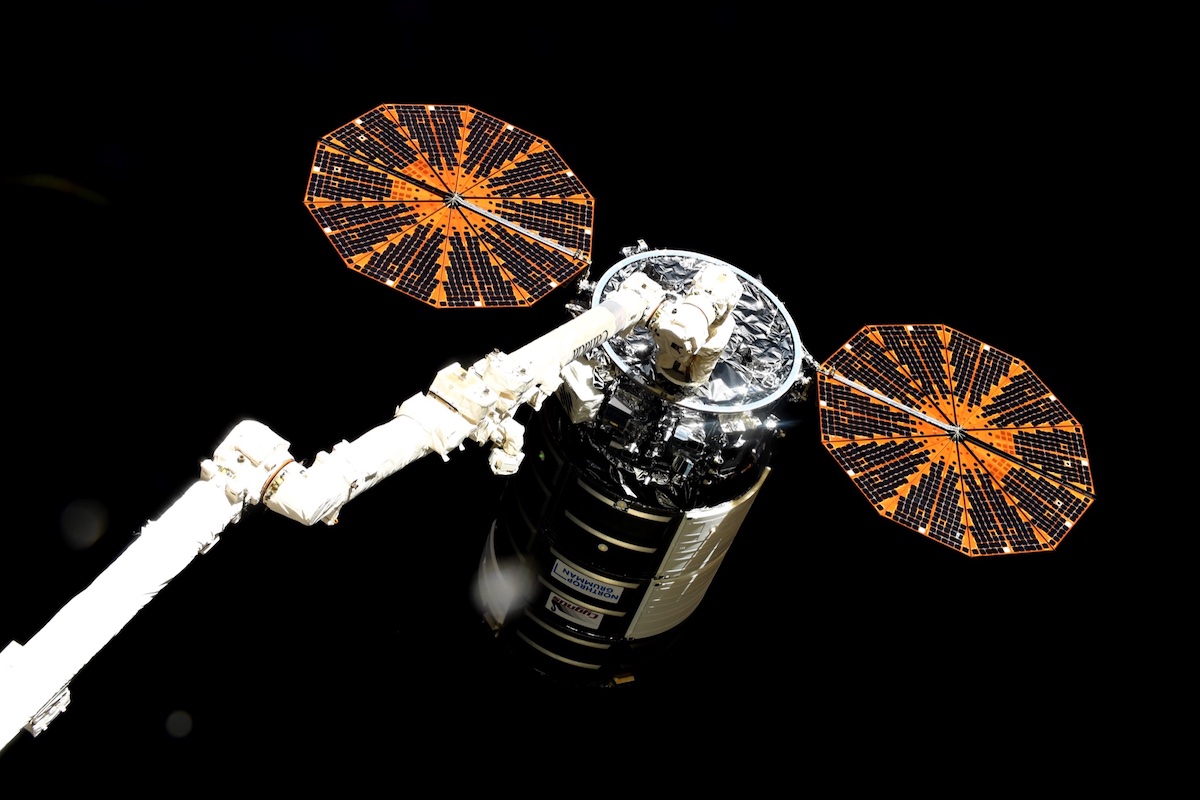
A commercial Cygnus supply ship from Northrop Grumman departed the International Space Station Tuesday, completing a four-month stay after delivering more than 8,000 pounds of cargo and boosting the research lab into a slightly higher orbit.
The Cygnus spacecraft was released from the space station’s Canadian-built robotic arm at 7:07 a.m. EDT (1107 GMT) Tuesday. Mission control delayed the release by an hour Tuesday to adjust the Cygnus spacecraft’s post-departure trajectory to be clear of space debris, and allow for improved communications with the cargo ship on its course away from the space station.
Ground teams commanded the robotic arm to release the Cygnus spacecraft. Mission control unberthed the Cygnus cargo ship from the station’s Unity module early Tuesday, then moved the robotic arm to position the departing spacecraft in the proper position for release below the orbiting research lab.
The Northrop Grumman supply freighter arrived at the space station Feb. 21, two days after launching from NASA’s Wallops Flight Facility in Virginia aboard an Antares rocket.
The mission is the 17th Cygnus resupply flight to the space station since 2013 under a series of commercial cargo transportation contracts with NASA. The supply delivery capability was originally developed by Orbital Sciences, now part of Northrop Grumman after a corporate acquisition in 2018.
Northrop Grumman named the Cygnus spacecraft for the NG-17 mission the “S.S. Piers Sellers” ini honor of a space shuttle astronaut and NASA climate scientist who died from cancer in 2016.
The pressurized cabin of the Cygnus spacecraft is packed with several tons of trash and other equipment no longer needed at the space station. After moving a safe distance from the complex, the Cygnus freighter will maneuver into higher orbit to deploy a CubeSat for Los Alamos National Laboratory.
The NACHOS satellite will spring out of a Nanoracks deployer mounted outside the Cygnus spacecraft, beginning a mission to demonstrate a new miniature imaging instrument to pinpoint sources of trace gases — natural emissions and air pollution generated by human activity — in the atmosphere.
The hyperspectral imager on the NACHOS mission has enough sensitivity to connect sulfur dioxide and nitrogen dioxide to specific volcanoes, cities, neighborhoods, and individual power plants, officials said. Hyperspectral imagers were once bulky instruments that required hosting by a larger satellite, but NACHOS is the first CubeSat to carry such an imager.
Hyperspectral instruments are tuned to resolving the chemical fingerprints of molecules, in the atmosphere or on Earth’s surface.
Once the 13-pound (6-kilogram) NACHOS satellite is deployed, the Cygnus spacecraft will perform a de-orbit burn Wednesday to fall back into the atmosphere. Most of the spacecraft, and its contents, will burn up over the Pacific Ocean.
The NG-17 mission delivered more than 8,300 pounds (about 3,800 kilograms) of cargo to the space station in February, including experiments, equipment to support new power-generating solar arrays, and a trash disposal system that will allow garbage to be jettisoned out of the station’s Nanoracks commercial airlock.
Using its gimbaled main engine, the Cygnus spacecraft also nudged the International Space Station into a slightly higher orbit Saturday, in one of the mission’s final tasks before leaving the complex. The maneuver lasted 5 minutes, 1 second, and raised the station’s altitude by 0.1 miles at apogee, or its highest point, and 0.5 miles at perigee, or its lowest point.
An attempt to reboost the station’s orbit June 21 was aborted after five seconds. NASA said the June 21 reboost attempt was terminated early as a “conservative measure due to system parameters that differed from Cygnus flight operations.”
Engineers determined the parameters were acceptable, and adjusted the limits for the next reboost try Saturday.
The space station’s orbit reboost capability has been exclusively provided by Russia since the retirement of the space shuttle in 2011. A Cygnus mission in 2018 tested the spacecraft’s ability to raise the station’s altitude, but the NG-17 mission was the first to employ the capability as an operational service.
Email the author.
Follow Stephen Clark on Twitter: @StephenClark1.
from Spaceflight Now https://ift.tt/U3kIOra
via World Space Info







0 comments:
Post a Comment